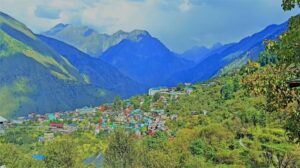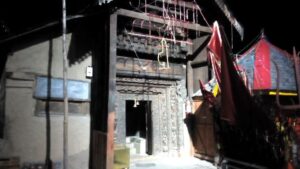
Bharmour, formally known as Brahmpura, was the ancient capital of Chamba state, India. Situated at an altitude of 7000 feet in the Budhil valley (32.26°N 76.32°E), to the south-east of Chamba. Distance between Chamba to Bharmour is 61 km by road. Bharmour is known for its scenic beauty, wildlife sanctuaries, waterfalls and for its ancient temples, hence making it one of the best tourist spots in Himachal Pradesh. Some of the temples are believed to date from 7th century. As the whole area around Bharmour is supposed to belong to lord Shiva, it is popularly spoken of as Shivabhumi, abode of lord Shiva. It is located between the Pir-Panjal and Dhauladhar range, between Ravi and Chenab valley. The land is blessed with deep beauty of abundant alpine pastures and provides home for nomadic shepherds, known as Gaddi, thus also called Gadderan. The foothills are filled with orchards and terraced farmsteads. The epitome of spirituality lies in this land as it is endow with ancient temples. The area goes through inhospitable terrain and severe climate changes. “Kailash Vasio” as the people of Bharmour are known are extremely courteous and welcomes you like their own family member. Along with its ethnic traditions, culture and ancient history, Bharmour forms the perfection of divine splendor.

History of Bharmour

Meru, the father of the first recorded prince Jaistambh in the Chamba Vanshavali was the first to settle Bharmour. He belonged to a ruling family of Ayodhya. Accompanied by his youngest son Jaistambh, Meru penetrated to the upper
Ravi valley through the outer hills. He defeated the petty Ranas holding the territory there and founded the town Brahmpura and made it the capital of a new state. This event is believed to have taken place in the middle of 6th century A.D.
According to one legend, the name Brahampura was in use at a still earlier period for the more ancient kingdom of Bharmour which existed in the territories of Garhwal and Kumaon, and that Maru gave the same name of Brahampura to the state that he founded with present Bharmour as his capital. After Maru, several Rajas ruled in succession until Sahil Varman. It was Sahil Varman who conquered the lower Ravi valley and transferred the seat of government from Brahampura to the new capital he founded at Chamba. Bharmour was capital for probably four hundred years.
The original state was of very small extent and in all likelihood comprised at the most the present Bharmour sub-division i.e. the valley of the Ravi below Bara Bangahal, with its tributaries, the Budhil and the Tundah as far down as Chhatrari.
Bharmour was the Vatika (garden) of goddess Brahmaani
According to a local legend, the place Brahampura was older than Maru’s time and as per common belief this used to be the vatika (garden) of goddess Brahmani who used to reside where her shrine now stands on the ridge at a distance of 3-4 kilometers. Brahmani Devi was having a son who was very fond of his pet chakor or (birds). One day the chakor was killed by a peasant and the son was shocked to death by this loss. Grief-stricken, Brahmani Devi also sacrificed by burying herself alive. The spirits of these trio dead souls started haunting the people awfully who raised Brahmani Devi to the status of deity and built her a temple. The people believe that the place was called Brahmpura after Brahamani Devi.
The legend further says that God Shiva with 84 Sidhas while on his way to Manimahesh happened to visit Brahmpura, the Vatika of the Goddess Brahmani Devi and settle there for the night. When Brahmani Devi, the presiding deity of the place saw the smoke of fires lit by the Sidhas, she felt very angry at this trespass. She came down to the place and ordered Shiva and the Sidhas to get out of the place. Shiva importuned in all his humility for allowing them to spend a night there. Goddess Brahamani condescended to their wishes. The 84 Mahasiddhas transformed themselves into 84 Lingas because they wished to settle there.
The Lord Shiva granted a boon to Brahamani Devi that all persons intending to go on pilgrimage to Manimahesh must have a dip in Bharmani Devi Temple pool. Failing this, their pilgrimage would not be acceptable to Lord Shiva.
In September 2007, the Government of Himachal Pradesh started chopper service to manimahesh located at an altitude of 14,000 ft.
Best time to visit Bharmour is from April to October but Bharmour can be visited throughout the year.
How to Reach Bharmour
The nearest airport to Bharmour is Gaggal Airport in Dharamshala, approximately 180 kilometers away. The nearest railway station is Pathankot, about 170 kilometers from Bharmour. From there, taxis and buses are readily available to reach Bharmour.
Accommodation in Bharmour
Bharmour offers various hotels, homestays, and guest houses where tourists can enjoy a comfortable and safe stay.
Bharmour’s beauty and tranquility make it a perfect summer destination. With a temperature of around 20 degrees Celsius and the surrounding natural splendor, it attracts visitors looking to escape the scorching heat and spend time in nature’s embrace.
Let’s explore the major landmarks that make Bharmour an ideal tourist destination.
1. Chaurasi Temple Complex
Located in Bharmour, this temple complex holds significant religious and historical importance. Known as the Chaurasi Temple Complex, it symbolizes the religious identity of Bharmour. The complex houses 84 temples dedicated to various deities, with the Manimahesh Temple, devoted to Lord Shiva, being the most prominent. The temple’s architectural brilliance and serene atmosphere attract both devotees and history enthusiasts.
2. Bharmani Mata Temple
Bharmani Mata Temple is a key religious site in Bharmour. Devotees come here to worship Goddess Bharmani Mata. Situated about 4 kilometers from the Chaurasi Temple Complex, this temple offers a panoramic view of Bharmour’s beautiful valleys, mesmerizing every visitor.
3. Ghared Waterfall, Thala Waterfall, and Hadsar Waterfall
These waterfalls in Bharmour are famous for their natural beauty. Ghared Waterfall, Thala Waterfall, and Hadsar Waterfall are ideal spots for those seeking peace and tranquility in the lap of nature. The lush green surroundings and cool breeze of these waterfalls provide tourists with a delightful experience, making them perfect picnic spots.
4. Kaksen-Bhagsen Waterfalls
Kaksen and Bhagsen Waterfalls are also major attractions in Bharmour. The tranquil environment here is very appealing. It is believed that Bhagsen Waterfall represents sins, while Kaksen Waterfall represents virtues. Legend has it that in the current age, known as Kaliyug, the increase in sins is depicted by the greater flow of water in Bhagsen Waterfall, whereas in Satyug, Kaksen Waterfall had a higher flow, symbolizing the abundance of virtues.
5. Kugti Wildlife Sanctuary and Tundah Wildlife Sanctuary
Kugti Wildlife Sanctuary and Tundah Wildlife Sanctuary are unique spots for wildlife lovers. Kugti Wildlife Sanctuary, located about 13 kilometers from Bharmour, is home to various Himalayan wildlife species, including the Himalayan black bear, musk deer, and snow leopard. It offers tourists an opportunity to experience nature’s beauty and observe wildlife closely.
Tundah Wildlife Sanctuary is known for its snowy landscapes and unique biodiversity. Spread over approximately 64 square kilometers, the sanctuary attracts tourists with its lush greenery and cool breezes.
6. Banni Mata Temple and Swami Kartikeya Temple, Kugti
Banni Mata Temple and Swami Kartikeya Temple hold religious and cultural significance. Banni Mata Temple, about 35 kilometers from Bharmour, is a major temple dedicated to Goddess Durga, where devotees come to fulfill their wishes.
Swami Kartikeya Temple in Kugti is dedicated to Lord Kartikeya. The spirituality and serenity of this temple attract many visitors.
7. Shiva Shakti Temple, Chhatrari
Shiva Shakti Temple in Chhatrari village is located about 33 kilometers from Bharmour at an altitude of 6,000 feet. Built in 650 AD by King Meru Varman, the temple is dedicated to Goddess Shiva Shakti. The main idol is a finely crafted brass statue of Shiva Shakti, holding a spear, a lotus, a bell, and a snake, representing energy, life, space, and time, respectively. The temple houses about thirty other small idols, including the family deity Annapurna.
8. Kugti Village and Grima Village Viewpoints
Kugti Village and Grima Village Viewpoints are renowned for their natural beauty. Kugti Village, situated within the Kugti Wildlife Sanctuary, symbolizes the traditional culture and lifestyle of Himachal Pradesh. Its peaceful environment attracts many tourists.
From the Grima Village Viewpoint, visitors can enjoy breathtaking views of the entire Bharmour valley, enchanting every onlooker.
9. Ghararu Forest Rest House and Eco Park
Ghararu Forest Rest House and Eco Park are ideal spots for nature lovers. The Ghararu Forest Rest House provides a comfortable and safe stay for tourists, allowing them to enjoy the natural beauty and take a break from their busy lives. Ghararu Eco Park is an environmental conservation site where visitors can experience the joy of mingling with nature.
10. Kugti Pass and Choiba Pass
Kugti Pass and Choiba Pass are famous for trekking. Kugti Pass, located at an altitude of about 5,020 meters, is a significant pass between Himachal Pradesh and Jammu and Kashmir, offering a challenging and thrilling experience for trekking enthusiasts. Choiba Pass, starting from Bharmour and extending to the Lahaul and Spiti districts, also provides spectacular views of the Himalayas, making it a memorable experience for trekkers.
11. Manimahesh Lake
Manimahesh Lake is believed to be the abode of Lord Shiva and hosts a grand pilgrimage every year. Located about 35 kilometers from Bharmour, this lake is one of the most sacred in Himachal Pradesh. Its natural beauty is captivating, attracting both devotees and nature lovers. The Manimahesh Yatra, held annually in August-September, sees thousands of pilgrims participating.
12. Dalotu Ghararu, Bhim Goda, Bharmani, Rajaur, Chobia, Dhanchho, Kugti, and Dughi Camping Sites
Bharmour offers several camping sites where tourists can enjoy the natural beauty. Dalotu Ghararu, Bhim Goda, Bharmani, Rajaur, Chobia Dhanchho, Kugti, and Dughi are popular camping sites. The clean environment and lush forests make camping here an exhilarating and memorable experience for tourists.
13. Lakewali Mata Temple and Holi Village
Lakewali Mata Temple and Holi Village hold both religious and natural significance. Lakewali Mata Temple, near Bharmour, is a major temple dedicated to Goddess Durga, where devotees come to fulfill their wishes. Holi Village is famous for its natural beauty and tranquil environment, offering tourists a peaceful retreat.
